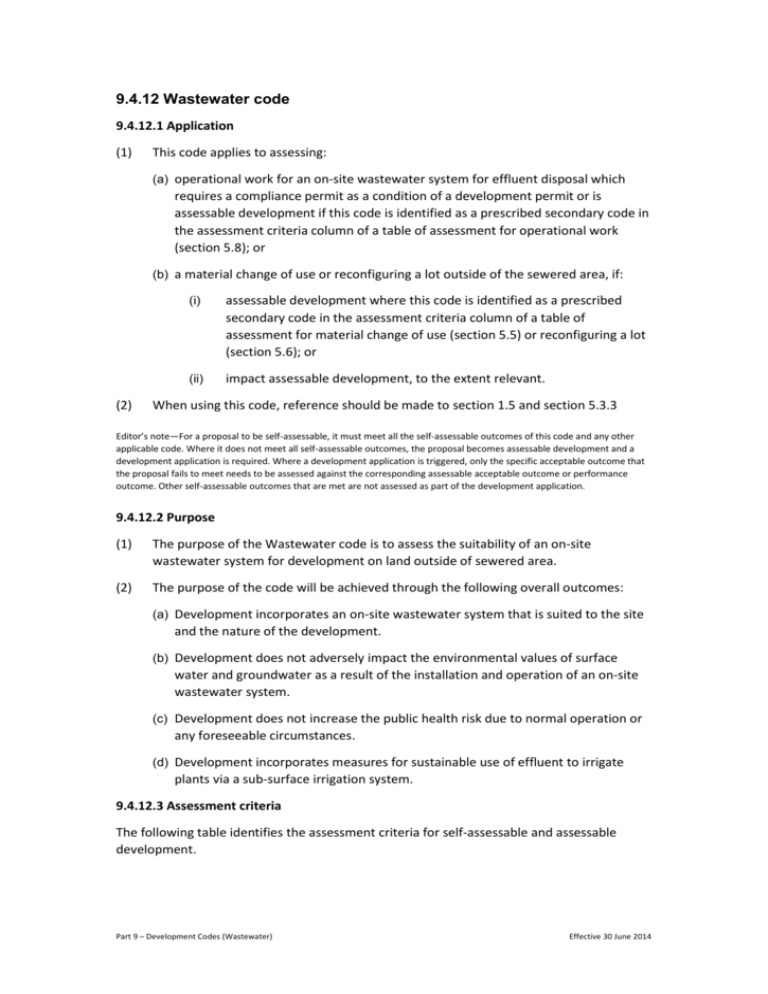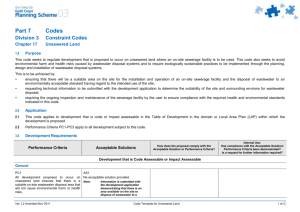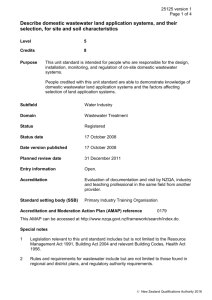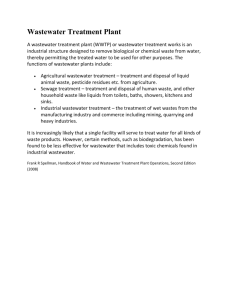Wastewater code - Brisbane City Council
advertisement

9.4.12 Wastewater code 9.4.12.1 Application (1) This code applies to assessing: (a) operational work for an on-site wastewater system for effluent disposal which requires a compliance permit as a condition of a development permit or is assessable development if this code is identified as a prescribed secondary code in the assessment criteria column of a table of assessment for operational work (section 5.8); or (b) a material change of use or reconfiguring a lot outside of the sewered area, if: (2) (i) assessable development where this code is identified as a prescribed secondary code in the assessment criteria column of a table of assessment for material change of use (section 5.5) or reconfiguring a lot (section 5.6); or (ii) impact assessable development, to the extent relevant. When using this code, reference should be made to section 1.5 and section 5.3.3 Editor’s note—For a proposal to be self-assessable, it must meet all the self-assessable outcomes of this code and any other applicable code. Where it does not meet all self-assessable outcomes, the proposal becomes assessable development and a development application is required. Where a development application is triggered, only the specific acceptable outcome that the proposal fails to meet needs to be assessed against the corresponding assessable acceptable outcome or performance outcome. Other self-assessable outcomes that are met are not assessed as part of the development application. 9.4.12.2 Purpose (1) The purpose of the Wastewater code is to assess the suitability of an on-site wastewater system for development on land outside of sewered area. (2) The purpose of the code will be achieved through the following overall outcomes: (a) Development incorporates an on-site wastewater system that is suited to the site and the nature of the development. (b) Development does not adversely impact the environmental values of surface water and groundwater as a result of the installation and operation of an on-site wastewater system. (c) Development does not increase the public health risk due to normal operation or any foreseeable circumstances. (d) Development incorporates measures for sustainable use of effluent to irrigate plants via a sub-surface irrigation system. 9.4.12.3 Assessment criteria The following table identifies the assessment criteria for self-assessable and assessable development. Part 9 – Development Codes (Wastewater) Effective 30 June 2014 Table 9.4.12.3—Criteria for self-assessable and assessable development Performance outcomes Acceptable outcomes PO1 AO1 Development ensures that the intensity and scale of the change of use of premises does not: Development ensures that the proposed disposal system complies with the requirements of: (a) increase any adverse ecological impacts, particularly on any nearby sensitive receiving environments, as a result of the system or increasing the cumulative effect of systems in the locality; (a) section 33 of the Environmental Protection Policy (Water) 2009; (b) increase any health risks during a system failure; (c) deteriorate the water quality of existing or proposed water supplies; (b) AS/NZS 1547:2012 On-site domestic wastewater management; (c) Plumbing and Drainage Act 2002; (d) the Queensland plumbing and wastewater code. Note—This is to be verified by a competent person and verification submitted to the Council with the development and plumbing application. (d) limit the sustainable disposal of domestic effluent. PO2 AO2.1 Development ensures that the lot size, configuration of new lots and location of the system allows for the efficient disposal of domestic effluent in a manner that: Development is on a lot with a minimum size of 2,000m2 or the minimum lot size specified for the relevant zone in the Subdivision code, whichever is the greater. (a) minimises any adverse ecological impacts, particularly on any nearby sensitive receiving environments; AO2.2 (b) limits any health risks during a system failure by ensuring that the water quality of existing or proposed water supplies remains unaffected along with the sustainable disposal of domestic effluent. Development ensures that the proposed on-site effluent disposal system is located on the lot in accordance with the: (a) secondary standards in Table A6 of the Interim Code of Practice for On-site Sewage Disposal; (b) Environmental Protection Policy (Water) 2009; (c) AS/NZS 1547:2012 On-site domestic wastewater management, (d) Plumbing and Drainage Act 2002; (e) Queensland plumbing and wastewater code. AO2.3 Development ensures that the proposed on-site effluent disposal system is subsurface and located on land: (a) with a slope of less than 15%, or where the land is terraced to receive the full Part 9 – Development Codes (Wastewater) Effective 30 June 2014 disposal area; (b) no closer than 150m to the limit of the ponded waters of a water supply reservoir or a town water intake; (c) above 1.7m AHD or above the Q20 flood levels, whichever is the higher and not within 9m horizontal distance of this level; (d) no closer than 25m to a cut or embankment. AO2.4 Development ensures that the proposed sub-surface on-site effluent disposal system is not located: (a) on soils with permeabilities less than 1.06m/day or greater than 3.5m/day; (b) within 0.6m of a permanent watertable; (c) within 1m of bedrock; (d) on land composed mainly of sand, gravel, fractured rock or heavy clay. AO2.5 Development ensures that a reserve land application area of up to 100% of the design area is available on the lot. AO2.6 Development ensures that the irrigation area is not separated from the dwelling by features such as gullies, creeks, dams, roads or driveways. Part 9 – Development Codes (Wastewater) Effective 30 June 2014






